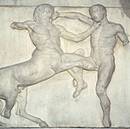
The Ancient Quarries on Mount Pendeli
Even since antiquity, Mt. Pendeli (ancient names Pentele, Pentelikon) (Elevation 1,109 metres) has been famous for its marble which was used for the construction of the Acropolis and other buildings of ancient Athens. Pentelic marble is flawless white with a uniform, faint yellow tint (caused by a trace of iron oxide), which makes it shine with a golden hue under sunlight. The ancient quarries are protected by law and used exclusively to obtain material for the Acropolis Restoration Project.
Scientists in the 1970s began to measure the stable isotopes of carbon and oxygen as a way to distinguish between marble varieties. A number of scholars have added to the database over the years, but Professor Scott Pike's study is the first systematic characterization of the Pentelikon quarry region.
In his doctoral dissertation for the University of Georgia, Pike points out that stable isotopes are atoms that have the same atomic number (the number of protons in the nucleus) but a different number of neutrons and therefore different atomic weights.
Calcite (Calcium Carbonate or CaCO3) is the primary mineral in marble, and since it is composed of carbon, oxygen and calcium, the conditions and manner in which calcite crystallizes affects the isotopic ratio.
With the cooperation of the Greek Ministry of Culture, Pike was allowed to undertake a thorough topographic and geologic field survey of the entire Pentelic quarry region.
Every one of the 164 ancient and modern quarries in the ancient quarry region on the south slope of Mount Pendeli was identified, geologically and topographically mapped and in most quarries multiple fresh marble samples were collected.
Pike noticed that three neighbouring (relatively parallel) quarry pits in the upper section of the quarry area have marbles with very high oxygen-18 ratios when compared to samples from all of the other Pentelic quarries, ratios that correlate with the published values of the Parthanon (Elgin) marbles. “The data not only confirms that the Parthanon marbles are Pentelic, we can now pinpoint the exact quarries from which the marble was extracted,” he says.
Quarry 1: 38 04' 33.55’’ North, 23 53' 07.06'' East Altitude: 920 metres
Quarry 2: 38 04' 32.92'' North, 23 53' 05.56'' East
Quarry 3: 38 04' 32.44'' North, 23 53' 04.52'' East
The Parthanon Marbles
They formed the 160 metre frieze wrapped around the top of the exterior wall of the building’s inner chamber. Originally, there were 92 metopes - individual sculptures in high relief - on the Parthenon. Of 64 that survived, 15 are in the British Museum and 18 remain in Athens. In some cases, parts of the same sculpture are divided between Athens and London

Marble Origins
Marble comes from the shells and exoskeletons (e.g. crustacia) of marine animals, deposited as limestone, buried by other sediment, then melted (usually by the heat of nearby volcanic intrusions) and re-solidified. This metamorphic process turns the amorphous (i.e. non-crystalline) limestone into a mass of interlocked calcite crystals. The temperatures and pressures necessary to form marble usually destroy any fossils that may have been present in the limestone. The characteristic swirls and veins of many coloured marble varieties are usually due to various mineral impurities.
RJH – 25/10/2008